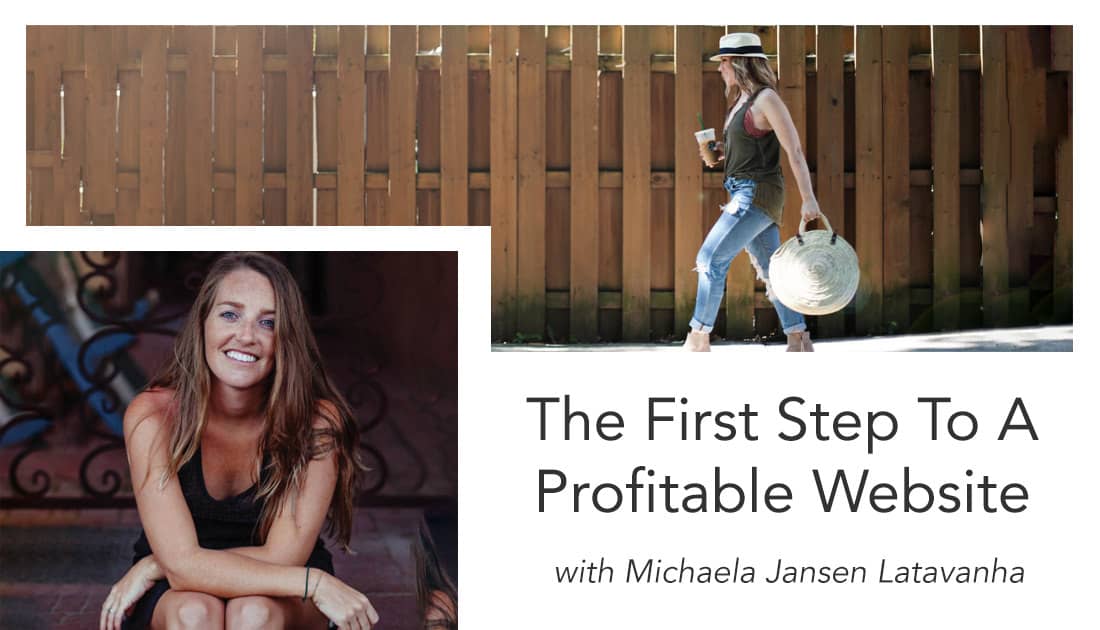

MICHAELA JANSEN LATAVANHA
GUEST WRITER
Founder & Creative Director, Beachside Studio
Michaela is a strategic web designer by day, and beachside… always. She’s been working with entrepreneurs for 8 years and specializes in creating great client experiences that transform clients into ambassadors for your brand. She believes your business should give you life instead of taking from it. Having a website that turns visitors into followers, prospects into clients, and clients into ambassadors can help you do just that.
It’s crazy how some people just seem to get it right. They grab your attention right away. It’s almost as if they possess mind-reading superpowers.
In reality, it’s not really all that hard. And I’ll show you how.
What is a profitable website?
[click_to_tweet tweet=”A profitable #website improves the quality of your visitors’ experience and their perception of your #business. – Michaela Jansen Latavanha” quote=”A profitable website improves the quality of your visitors’ experience and their perception of your business.” theme=”style3″]
If you have a deep understanding of your ideal client or customer’s needs, desires, pain points and values, you are better equipped to create an experience that, firstly, predicts visitors’ questions or steps and guides them through your site.
Secondly, a profitable website shows prospective clients and customers that you have an answer for their problems or needs.
And thirdly, it helps visitors find what they are looking for, take action, buy, or subscribe.
In essence, profitable websites are built with an ideal client or two in mind.
Scrap the ‘ideal client avatar’ exercise
This is not one of those dreaded ideal client avatar exercises, I promise. Keep reading. What I’m about to share is a lot more valuable, helpful and fun.
It’s important to get to know the audience you’re aiming to speak to, but answering typical questions about an ideal client doesn’t tend to get you the insights you need. [click_to_tweet tweet=”To build the best online experience you need to understand a visitor’s mindset and decision-making process. Real data helps you achieve this, not a fictional character. – Michaela Jansen Latavanha #website #marketing” quote=”To build the best online experience you need to understand a visitor’s mindset and decision-making process. Real data helps you achieve this, not a fictional character.” theme=”style3″]
But, how?
- We gather data. This could be from interviews, surveys, observation (think heat maps, user testers, and Google Analytics), things you’ve heard them say in Facebook groups or on their blogs, reviews on similar services/offerings as yours and/or talking and working with them.
- We create an empathy map. Armed with that info, you can create a real, relatable persona that you can empathise with.
What to look for when gathering data
We want to understand what happened that made them start searching for a solution. What was the trigger? For example, someone looking for a wedding photographer would’ve been triggered by the fact that they got engaged. This doesn’t need to be a big event, it could just be a feeling or something someone said.
What are they looking for when they are considering a product/service/offering like yours? What is important to them? What are the deal or no-deal factors? What are their concerns?
What does their life look like before and after? Or what does their life look like now and how do they want their life to be?
Keep a spreadsheet of things you hear your ideal client say in Facebook groups (copy & paste their exact words), and look at reviews and testimonials on offerings similar to yours. Amazon & people’s sales pages are great for this, especially the video testimonials.
Keep track of what your clients tell you. Record calls or meetings with clients (remember to ask for their permission first) and get them transcribed.
Do an interview with your ideal client. Again record and get it transcribed. You don’t need to do many. You’ll find that you will start to see a pattern after about 5 interviews. I highly recommend reading the book Buyer Personas by Adele Revella to learn how to effectively interview ideal clients.
Use tools like Hotjar and Inspectlet to analyze how people are using your website through heat maps and recorded sessions. Watch how people use your website. How far do they read? What do they click on? What pages do they navigate to and in what order? All of this can give you great insights into what they are considering before they hire/buy from you and what they are looking for on your website.
The idea is that you keep track of what your ideal client actually says and do and not what you think they say and do.
Armed with all this info we move over to an empathy map. This is a tool I use with all my clients. (Originally created by Xplane.)
How does the empathy map work?
Imagine you’re watching your client’s day a la “The Truman Show” (but less creepy). We’re going to ‘watch’ your client, and write down the things that they see, experience, think and feel. We’re basically creating a story about our client that we’ll use to refine the customer experience on your website.
Get your Post-it notes out, download the Empathy Map from Xplane and work your way clockwise starting with ‘Goal’.
First, we identify who this person is and give them a name.
Then we establish the action we want them to take. What do they need to do differently, what decision do they need to make, etc.?
Working your way around the map we write down what it feels like to be them.
To give you an example, here’s how I did this exercise:
“Bianca is a 30-something, work-from-home mom who loves her job and family, but feels more hectic than she would like. She wakes up and is excited to start her day because she’s running a business that she loves. She makes a cup of coffee, scrolls through Instagram and feels a thrill at the likes and comments she got through the night. She gets the kids ready for school and comes home to a quiet house, but feels a small pang of loneliness at being at home by herself all day. After an already full morning, she finally gets to sit down at her computer and check emails, and it feels like her inbox has been flooded.
Her business is going well, but she knows there are gaps in her process. She’s losing time and potential clients. She feels the same frustration she felt yesterday and the day before as she tries to remember whether or not she needs to send a follow-up email, and gets an anxious pit in her stomach when she sees a long stretch on her calendar with NO bookings. She takes a break, pours another cup of coffee, and scrolls through Instagram again to try to soothe her anxieties.”
I continued to ‘follow’ Bianca like this, making notes on my empathy map as I went.
Got it? We’re creating a story about our client defining all the things she does, see, experiences and feels, as it relates to your product/services/offering. It might feel weird at first, but it can be pretty addictive.
Gaining that deep understanding of your ideal client will build the foundation of your profitable website. It will guide your website content and design turning your website into a sales tool for your business.
I’m so eager to know how this goes for you!



